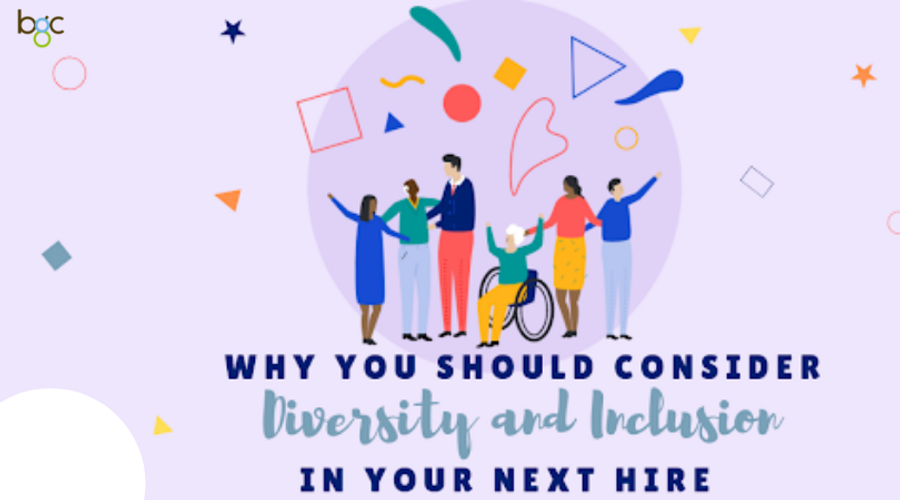One of the greatest challenges that HR leaders and recruitment agencies in Singapore face today is the rapid pace with which workplace demographics are changing both locally and globally. The emerging markets, advances in technology and cultural evolution will continue to play a major role in shaping a more complex corporate ecosystem and create new barriers in recruitment and talent retention in years to come.
The term “Workplace Diversity and Inclusion” is a trend and business leaders all around the world are jumping aboard the bandwagon to seek a more creative, collaborative and cohesive workplace for all their employees.
People often confuse inclusion for diversity. However, both are terms are non-mutually exclusive and only drive growth for a company when correctly understood. Here are the differences between the two terms and how each can benefit your company.
Workplace Diversity
The Society for Human Resource Management (SHRM) defines workplace diversity as “the collective mixture of differences and similarities that includes for example, individual and organisational characteristics, values, beliefs, backgrounds, experiences, behaviors, and preferences.”
Diversity can be split into 2 categories - visible and invisible diversity traits:
-
Visible diversity traits are features that can be observed on the surface; think of it as the tip of an iceberg. It includes traits like race, gender, (dis)abilities, body type, and age.
-
Invisible diversity traits include sexual orientation, education, economic status and more.
Hence, workplace diversity is the acceptance, understanding and valuing of every employee who comes through the selection process.
Workplace Inclusion
Inclusion, though similar, is another concept of diversity. The SHRM defines inclusion as “the achievement of a work environment in which all individuals are treated fairly and respectfully, have equal access to opportunities and resources, and can contribute fully to the organisation’s success.” Basically, inclusion means a collaborative, and respectful environment that supports the fair contribution and participation of all employees.
Workplace Diversity and Inclusion (D&I)
When both terms are combined together, it becomes a company’s strategy, mission, and policies that are put in place to support a diverse workplace. A clear understanding of what D&I is important because most companies only focus on the former and neglect the latter. As a result, disappointing outcomes surface, defeating the purpose of having diversity in the first place.
Welcoming workplace D&I gives your company a competitive edge by bringing in unique perspectives to the company and helps your employees feel appreciated.
Not convinced? Here are five other great reasons why human resource professionals should consider improving D&I when hiring future employees:
1. It gives your company brand and reputation a boost
Workplace D&I boosts your company’s public brand and reputation. Workplace D&I shines a positive light on the company as your company is seen as more human, and more socially responsible not only to potential candidates but clients as well.
In 2016, Weber Shandwick released their Gender Forward (GFP) Index that measures the percentage of women holding senior managerial roles in the Fortune 500 companies. Organizations that ranked highly have twice as many women in senior managerial positions when compared to companies with lower rankings.
With strong employer branding, you are able to attract the best talents and business partners while staying real and relevant in the industry.
2. Your employees become more engaged
In research conducted by Deloitte, the more an employee feels included, the more engaged they are at work. Absenteeism goes down as employees are motivated to do their best to contribute.
Also, it has been proven in a study by Catalyst that innovation drives engagement. India, China, and Mexico are three of the six countries they studied and these three countries reported a 62%, 78%, and 51% increase in innovation when D&I in the company is present.
3. Lower rate of employee turnover
Companies with high retention usually have a more diverse work culture that is usually inclusive and receptive of different individual perspectives and characteristics. When employees feel appreciated, they are also contented in their workplace and tend to stay for a longer duration with the company.
4. A myriad of varying perspectives
Diversity means having employees of different backgrounds, characteristics, skill sets, views, and experiences. Therefore, higher workplace D&I means that the employees have higher access to a myriad of varying perspectives, which are highly essential when it comes to planning company strategies.
In a study discussing the behaviours of the directors when it comes to decision-making, a greater level of creativity were observed as there was a “deep-level” of diversity (i.e., differences in values, personalities, and backgrounds).
Also, when diverse leaders are absent, women (20%), LGBT employees (21%) and people of colour (24%) are more unlikely to have their ideas endorsed.
5. Increase in profits
Forbes reported that "increasing the diversity of leadership teams leads to more and better innovation and improved financial performance."
With improved innovation that comes with a diverse team, companies have observed a 19% increase in revenue. This finding is a breakthrough for start-ups, tech companies, and industries where innovation drives growth.
Both diversity and inclusion work together to cultivate a strong workplace culture that contributes to the company’s success. The advantages of building a workforce empowered to positively contribute to the success of a company are numerous.
As such, it is important that top executives and HR managers are well informed on how implementing appropriate HR policies alongside their HR partners and recruitment agencies could help optimize the workplace culture for success.
BGC Group, established since 2005, is dedicated to working with candidates and clients from all walks of life no matter race, ethnicity, age and many more, staying true to our vision of Bridging & Growing Careers Because We Care.
To find out how to work with BGC, contact us at:
Employers: https://www.bgc-group.com/employers
Candidates: https://www.bgc-group.com/job-search
Passionate about human resources? Join us as a consultant!
